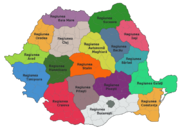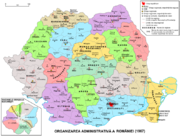
Hungarian Autonomous Province
Encyclopedia

Romanian language
Romanian Romanian Romanian (or Daco-Romanian; obsolete spellings Rumanian, Roumanian; self-designation: română, limba română ("the Romanian language") or românește (lit. "in Romanian") is a Romance language spoken by around 24 to 28 million people, primarily in Romania and Moldova...
: Regiunea Autonomă Maghiară, Hungarian
Hungarian language
Hungarian is a Uralic language, part of the Ugric group. With some 14 million speakers, it is one of the most widely spoken non-Indo-European languages in Europe....
: Magyar Autonóm Tartomány) and Mureş-Magyar Autonomous Region (1960-1968) were autonomous regions in the People's Republic of Romania
Communist Romania
Communist Romania was the period in Romanian history when that country was a Soviet-aligned communist state in the Eastern Bloc, with the dominant role of Romanian Communist Party enshrined in its successive constitutions...
(later Socialist Republic of Romania
Communist Romania
Communist Romania was the period in Romanian history when that country was a Soviet-aligned communist state in the Eastern Bloc, with the dominant role of Romanian Communist Party enshrined in its successive constitutions...
).
History
In 1950, Romania adopted a Soviet-style administrative and territorial divisionAdministrative divisions of the Peoples' Republic of Romania
The regions represented the result of a Soviet-inspired experiment regarding the administrative and territorial organisation of the People's Republic of Romania , between 1950 and 1968.-History:...
of the country into regions and raions (until then, Romania
Romania
Romania is a country located at the crossroads of Central and Southeastern Europe, on the Lower Danube, within and outside the Carpathian arch, bordering on the Black Sea...
had been divided into judeţ
Judet
A județ is an administrative division in Romania, and was also used for some time in Moldova, before that country switched to raions.Județ translates into English as jurisdiction, but is commonly mistranslated as county .The territory of Romania is divided for administrative purposes into 41...
e or counties).
Two years later, in 1952, the number of regions was reduced and by comprising ten raion
Raion
A raion is a type of administrative unit of several post-Soviet countries. The term, which is from French rayon 'honeycomb, department,' describes both a type of a subnational entity and a division of a city, and is commonly translated in English as "district"...
s from the former Mureş Region and from the Stalin Region (both of them created in 1950), of the territory inhabited by a compact population of Székely
Székely
The Székelys or Székely , sometimes also referred to as Szeklers , are a subgroup of the Hungarian people living mostly in the Székely Land, an ethno-cultural region in eastern Transylvania, Romania...
Hungarians, a new region called the Magyar Autonomous Region was created. According to the 1956 census, the total population of the region was 731,361, distributed among the ethnic groups as follows: Hungarians (77.3%), Romanians
Romanians
The Romanians are an ethnic group native to Romania, who speak Romanian; they are the majority inhabitants of Romania....
(20.1%), Gypsies (1.5%), Germans (0.4%) and Jews
Jews
The Jews , also known as the Jewish people, are a nation and ethnoreligious group originating in the Israelites or Hebrews of the Ancient Near East. The Jewish ethnicity, nationality, and religion are strongly interrelated, as Judaism is the traditional faith of the Jewish nation...
(0.4%). The official languages of the province were Hungarian
Hungarian language
Hungarian is a Uralic language, part of the Ugric group. With some 14 million speakers, it is one of the most widely spoken non-Indo-European languages in Europe....
and Romanian
Romanian language
Romanian Romanian Romanian (or Daco-Romanian; obsolete spellings Rumanian, Roumanian; self-designation: română, limba română ("the Romanian language") or românește (lit. "in Romanian") is a Romance language spoken by around 24 to 28 million people, primarily in Romania and Moldova...
and the provincial administrative centre was Târgu-Mureş
Târgu-Mures
Târgu Mureș is the seat of Mureș County in the north-central part of Romania. As of January 1, 2009 the city had a population of 145,151 inhabitants, making it the 16th most-populated city in Romania.-Names and etymology:...
(Marosvásárhely).
Its status laid out in the 1952 Constitution
1952 Constitution of Romania
The 1952 Constitution of Romania, also called the "constitution of building socialism", expressed the consolidation of Communist power, featuring greater ideological content than its 1948 predecessor. A draft was written by a commission elected by the Great National Assembly on March 27, 1952 and...
, the region encompassed about a third of Romania's Hungarians, the rest living either in more Romanian areas or along the border with Hungary, where an ethnic-based region might have stoked fears of irredentism and security concerns. In practice, the region's status differed in no way from that of the other seventeen regions and it did not enjoy autonomy of any kind–laws, decisions and directives from the centre were rendered compulsory by the very constitution that created it, and the State Council of the Autonomous Region was merely a façade. The Region's only distinguishing features were that most of its officials were Hungarian, the Hungarian language could be used in administration and the courts, and bilingual sign
Bilingual sign
A bilingual sign is the representation on a panel of texts in more than one language...
s were put up on public buildings. Moreover, the specifically Hungarian wing of the Romanian Communist Party
Romanian Communist Party
The Romanian Communist Party was a communist political party in Romania. Successor to the Bolshevik wing of the Socialist Party of Romania, it gave ideological endorsement to communist revolution and the disestablishment of Greater Romania. The PCR was a minor and illegal grouping for much of the...
was abolished in 1953, ending any mechanism for defending of the Hungarian minority's collective rights.
In December 1960 a governmental decree modified the boundaries of the Magyar Autonomous Region. Its southern raions were reattached to Braşov Region (former Stalin Region) and in place of this, several raions were joined to it from the Cluj Region
Regiunea Cluj
Regiunea Cluj was one of the newly established administrative divisions of the People's Republic of Romania, set after the soviet style.-History:...
. The region was called the Mureş Region-Magyar Autonomous, after the Mureş River
Mures River
The Mureș is an approximately 761 km long river in Eastern Europe. It originates in the Hășmașu Mare Range in the Eastern Carpathian Mountains, Romania, and joins the Tisza river at Szeged in southeastern Hungary....
. The ratio of Hungarians was thus reduced from 77.3 percent to 62 percent.
In 1968, the Great National Assembly
Great National Assembly
The Great National Assembly was the legislature of the Romanian People's Republic and the Socialist Republic Romania. When Communism was overthrown in Romania in December 1989, the National Assembly was replaced by a bicameral parliament, made up of the Chamber of Deputies and the Senate.The Great...
put an end to the soviet style administrative division of the country into regions and re-introduced the historical judeţ (county
County
A county is a jurisdiction of local government in certain modern nations. Historically in mainland Europe, the original French term, comté, and its equivalents in other languages denoted a jurisdiction under the sovereignty of a count A county is a jurisdiction of local government in certain...
) system, still used today. This also automatically eliminated the Mureş-Magyar Autonomous Region and replaced it with counties that are not identified with any nationality. The two new counties formed on the majority of the territory of former Mureş-Magyar Autonomous Region are Mureş
Mures County
Mureș is a county of Romania, in the historical region of Transylvania, with the administrative centre in Târgu Mureș.-Geography:The county has a total area of 6,714 km²....
and Harghita
Harghita County
Harghita is a county in the center of Romania, in eastern Transylvania, with the county seat at Miercurea-Ciuc.-Demographics:In 2002, it had a population of 326,222 and a population density of 52/km².*Hungarians- 85%...
plus one from the former Magyar Autonomous Region until 1960 and part of the Braşov Region in 1968, Covasna
Covasna County
Covasna is a county of Romania, in Transylvania, with the capital city at Sfântu Gheorghe.-Demographics:In 2002, it had a population of 222,449 and the population density was 60/km².*Hungarians – 73.79% *Romanians – 23.28%...
.
In two of these counties, Harghita and Covasna, Hungarians form the majority of inhabitants. The Romanian law enables the usage of the language of an ethnic minority which forms at least 20% of the population of a municipality in relation with the administration, and the state provides education and public signage in the language of the respective ethnic minority.
Neighbors

- Magyar Autonomous Region had as neighbors (1952-1960):
East: Bacău
Regiunea Bacau
Regiunea Bacău was one of the newly established administrative divisions of the People's Republic of Romania, copied after the Soviet style of territorial organisation.-History:...
and Bârlad
Regiunea Bârlad
Regiunea Bârlad was one of the newly established administrative divisions of the People's Republic of Romania, copied after the Soviet style of territorial organisation.-History:...
Regions;
South: Stalin and Ploieşti Regions;
West: Cluj Region
Regiunea Cluj
Regiunea Cluj was one of the newly established administrative divisions of the People's Republic of Romania, set after the soviet style.-History:...
;
North: Suceava Region
- Mureş Region-Magyar Autonomous had as neighbors (1960-1968):
East: Bacău Region
Regiunea Bacau
Regiunea Bacău was one of the newly established administrative divisions of the People's Republic of Romania, copied after the Soviet style of territorial organisation.-History:...
;
South: Braşov Region;
West: Cluj Region
Regiunea Cluj
Regiunea Cluj was one of the newly established administrative divisions of the People's Republic of Romania, set after the soviet style.-History:...
;
North: Suceava region
See also
- Regions of the Peoples' Republic of Romania
- Hungarian minority in Romania
- SzékelySzékelyThe Székelys or Székely , sometimes also referred to as Szeklers , are a subgroup of the Hungarian people living mostly in the Székely Land, an ethno-cultural region in eastern Transylvania, Romania...
- Székely LandSzékely LandThe Székely Land or Szekler Land refers to the territories inhabited mainly by the Székely, a Hungarian-speaking ethnic group from eastern Transylvania...
- Ethnic clashes of Târgu MureşEthnic clashes of Târgu MuresTârgu Mureş is a town in Romania with an ethnically mixed population that was almost equally distributed between Romanians and Hungarians after the fall of the communist regime in December 1989. In March 1990, short-lived, but violent clashes occurred there between the two ethnic groups in the...
- Northern TransylvaniaNorthern TransylvaniaNorthern Transylvania is a region of Transylvania, situated within the territory of Romania. The population is largely composed of both ethnic Romanians and Hungarians, and the region has been part of Romania since 1918 . During World War II, as a consequence of the territorial agreement known as...
- TransylvaniaTransylvaniaTransylvania is a historical region in the central part of Romania. Bounded on the east and south by the Carpathian mountain range, historical Transylvania extended in the west to the Apuseni Mountains; however, the term sometimes encompasses not only Transylvania proper, but also the historical...
External links
- Map: Közigazgatási Beosztás 1956 Map of the administrative divisions in TransylvaniaTransylvaniaTransylvania is a historical region in the central part of Romania. Bounded on the east and south by the Carpathian mountain range, historical Transylvania extended in the west to the Apuseni Mountains; however, the term sometimes encompasses not only Transylvania proper, but also the historical...
in 1956, including the Hungarian Autonomous Province - Map: Közigazgatási Beosztás 1966 Map of the administrative divisions in TransylvaniaTransylvaniaTransylvania is a historical region in the central part of Romania. Bounded on the east and south by the Carpathian mountain range, historical Transylvania extended in the west to the Apuseni Mountains; however, the term sometimes encompasses not only Transylvania proper, but also the historical...
in 1966, including the Mureş-Hungarian Autonomous Province - Map: A Székelyföld autonómiája, 1952-1968 ("Autonomous Székelyföld, 1952-1968"): Map of the Hungarian Autonomous Province (1952-1960) and Mureş-Hungarian Autonomous Province (1960-1968)
- Map: Republica Populară Română, Structura Administrativ-Teritorală (1952) ("Romanian People's Republic, Administrative-Territorial Structure (1952)"), showing the Hungarian Autonomous Province ("Reg. Autonomă Maghiara").

